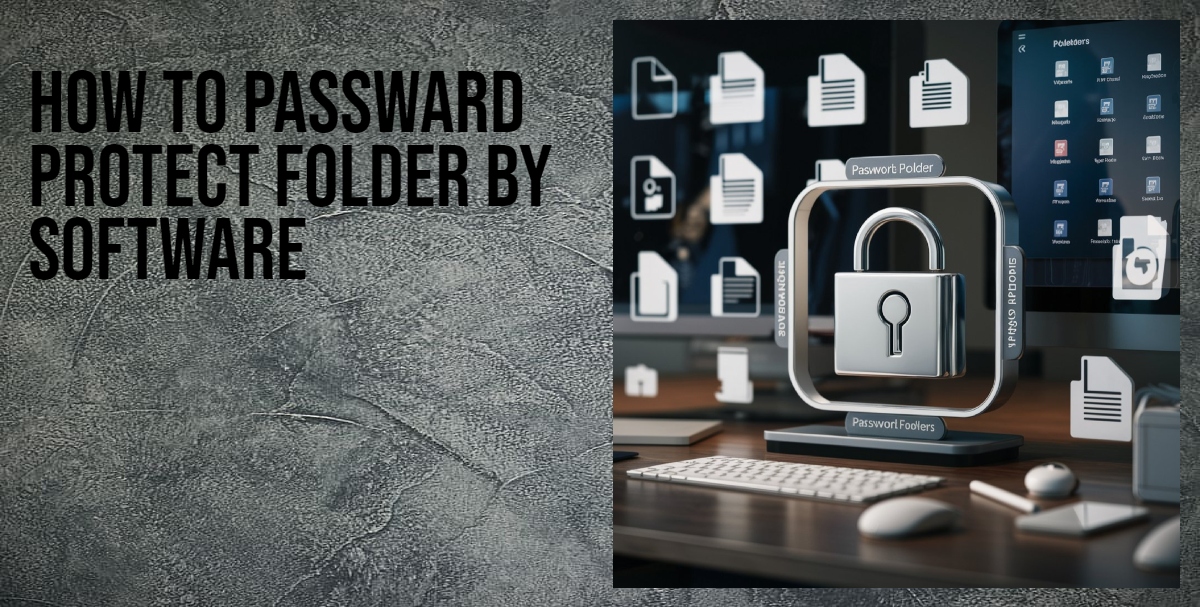In today’s digital world, keeping your data safe is crucial for both people and companies. One great way to protect your files is by using passwords on your folders. Luckily, there are many software tools that make this easy and straightforward. We’ll look at different options, show you how to set up folder encryption, and talk about the best ways to manage your folder passwords.
A folder with a padlock on it, as if protected by a password. The padlock should look sturdy and secure, with a metallic shine. The folder itself should appear plain and nondescript, but also well-organized and professional. The background can be either a solid color or a subtle gradient, but no other objects or distractions should be present in the image.
Key Takeaways
- Explore a range of software solutions to password protect your folders and secure your data.
- Learn the step-by-step process of setting up folder encryption for enhanced privacy and security.
- Discover best practices for effective folder password management to ensure the long-term protection of your sensitive files.
- Understand the importance of folder security in the digital age and how it can protect your valuable information.
- Gain insights into integrating folder protection with cloud storage for comprehensive data security.
Introduction to Folder Password Protection
In today’s digital world, keeping your files and folders safe is key. It’s vital to protect your data from unauthorized access. This is because data breaches can lead to serious issues, whether it’s for business or personal reasons.
By password-protecting your folders, you’re taking a simple yet effective step to boost your digital security. This helps keep your sensitive information safe and private.
Why Folder Security Matters
The importance of folder security is huge. Without protection, your data could be at risk. This means your sensitive info, financial details, or even your personal identity could be stolen.
The password protection benefits go beyond just stopping data breaches. They also let you control your digital stuff and keep your info confidential.
Overview of Software Solutions
- There are many software for folder encryption options out there, meeting different needs and tastes.
- These tools provide strong password protection, encrypt files, and give you detailed access controls to secure your data.
- You can pick from paid, top-tier tools or free, open-source ones, depending on what you need and can afford.
Learning about the importance of folder security and the software for folder encryption available helps you protect your digital stuff. This way, you can rest easy knowing your files are safe and well-protected.
Evaluating Your Folder Security Needs
Before picking a tool to protect your folders with passwords, think about what you really need for security. This will help you figure out which folders need the most protection. It will also show you what features are most important to you.
When assessing folder security requirements, think about these things:
- Sensitive content: Find out which folders have sensitive info, like financial records, personal documents, or confidential business data.
- Access control: Decide who should get into the protected folders and how to manage their permissions.
- Compliance and regulations: Make sure your folder protection meets any rules or laws your industry has.
- Backup and recovery: Think about how important it is to have good backup and recovery options if you lose passwords or systems fail.
- Usability and convenience: Look at how easy the folder protection software is to use and how it fits into your daily work.
By carefully evaluating the factors to consider for folder protection, you can pick the best folder password protection tool for you. This will boost the security of your important data and make managing your files easier.https://www.youtube.com/embed/zghYdApNzww
“Protecting your sensitive data should be a top priority, and the right folder password protection solution can make all the difference.”
Popular Folder Password Protection Tools
There are many software solutions to protect your sensitive folders, both paid and free. If you want the best folder password protection software or something more affordable, it’s key to look at the main features. This helps you pick the right one for your needs.
Paid Software Options
Paid software gives you top-level folder security. These tools have advanced encryption, multi-factor authentication, and work well with cloud storage. Some top folder password protection paid options are:
- Folder Lock: It has strong encryption, password management, and file shredding.
- AxCrypt: It offers end-to-end encryption, secure sharing, and cloud collaboration.
- WinZip: It’s known for its file compression and encryption, including folder protection.
Free and Open-Source Alternatives
If you’re on a budget or want more flexibility, free and open-source folder password protection tools are good choices. They might not have as many features as paid ones, but they still keep your folders safe. Some free and open-source options include:
- VeraCrypt: A popular, open-source encryption tool for protecting folders or drives.
- 7-Zip: A free file archiver with password-protected compression for folders.
- DiskCryptor: A full disk encryption solution that also secures folders.
When deciding between paid vs. free folder password protection tools, think about ease of use, features, and security. By comparing them, you can find the best one for your folder security needs.
| Feature | Paid Solutions | Free Solutions |
|---|---|---|
| Encryption Strength | High-grade encryption, often with advanced algorithms | Varies, but can still provide reliable protection |
| User Interface | Typically more intuitive and user-friendly | May have a steeper learning curve |
| Additional Features | Offer advanced features like multi-factor authentication, cloud integration, and file shredding | Focus more on core folder protection functionality |
| Technical Support | Provide dedicated customer support | Rely on community forums and documentation |
The choice between paid vs. free folder password protection tools depends on what you need, your budget, and your tech skills. Knowing the feature comparison helps you make a smart choice for your needs.
Step-by-Step Guide to Password Protecting Folders
Protecting your digital files and folders is key in today’s world. We’ll show you how to password protect your folders with different software. You’ll learn from picking the right tool to encrypting folders.
Choosing the Right Software
First, pick the right software to protect your folders. Think about how easy it is to use, how secure it is, if it works with your computer, and if you want a free or paid option. Options include Microsoft’s BitLocker, VeraCrypt, and 7-Zip, each with its own features.
Setting Up Folder Encryption
After choosing your software, set up folder encryption. This means creating a secure space, setting a strong password, and putting your important files there. The folder encryption process changes with the software, but most give easy steps to follow.
Remember, your password’s strength is key to keeping your folders safe. Choose a complex, unique password with letters, numbers, and special characters. Don’t use easy-to-guess info like birthdays or common words.
“Protecting your digital assets through proper folder encryption is an essential step in safeguarding your privacy and sensitive information.”
By following this guide, you can how to password protect folders well. This keeps your important files safe from people who shouldn’t see them.
Best Practices for Folder Password Management
Keeping your password-protected folders safe is a continuous task. We’ve put together some top tips to help you keep your sensitive data secure. These practices will make sure your important files stay protected over time.
Create Strong Passwords
Choosing a strong, unique password for your folders is key. Don’t use common words, personal info, or easy-to-spot patterns. Go for a mix of uppercase and lowercase letters, numbers, and special characters. This makes your password hard to guess and keeps out unwanted visitors.
Regularly Update Passwords
It’s smart to change your folder passwords now and then, even if nothing has gone wrong. This step lowers the chance of someone getting into your files by mistake. It keeps your data safe and sound.
Implement Password Management Tools
Using a good password manager can make managing your folder passwords easier. These tools can make strong passwords for you, keep them safe, and fill them in when you need them. It cuts down on mistakes and makes keeping track of passwords simpler.
Keep Backups of Your Passwords
Having a backup of your passwords can save the day if you forget one. Keep them in a secure spot, like a password manager or a locked journal. This way, you can always get back into your files when you need to.
Educate Yourself on Best Practices
It’s important to keep up with the latest tips on password security. Check out industry advice, go to security seminars, or talk to IT experts. This helps you use the best folder password management tips out there.
By sticking to these best practices, you can keep your password-protected folders safe and easy to get into. This protects your important data from threats.
How to Password Protect Folders by Software
Protecting your sensitive files and folders is key in today’s digital world. Luckily, there are many software solutions to help you do this. We’ll show you how to password protect your folders using different encryption software.
Choosing the Right Folder Encryption Software
First, pick the right software to protect your folders. Some top choices are:
- Microsoft BitLocker (Windows 10 and 11)
- VeraCrypt (cross-platform)
- GnuPG (open-source, command-line tool)
- 7-Zip (free compression and encryption tool)
Think about how easy it is to use, its security features, and if it works with your computer when picking software.
Setting Up Folder Encryption
After choosing software, here’s how to protect your folders:
- Install the encryption software on your computer.
- Open the software and find the folder you want to protect.
- Create a new encrypted volume or container for the folder.
- Set a strong, unique password to secure the encrypted folder.
- Move or copy the folder contents into the encrypted volume.
- Access the folder by entering the password to view or change its contents.
1. A computer screen with a folder icon on it. 2. A lock icon appearing on top of the folder. 3. A sequence of buttons being pressed to activate the password protection. 4. A padlock icon appearing on the folder, indicating that it is now password-protected. 5. A hand cursor hovering over the folder, unable to access it without the correct password. 6. The password prompt box appearing on the screen as the user attempts to open the folder. 7. A checkmark appearing next to the correct password, allowing access to the protected folder. 8. An alert box popping up when an incorrect password is entered, warning of limited login attempts. 9. A progress bar filling up as the correct password is being entered, indicating successful login.
By following these steps, you can protect your folders with encryption software. This keeps your important data safe and lets only those you trust access it.
Integrating Folder Protection with Cloud Storage
Cloud storage is becoming more popular, so it’s key to keep your password-protected folders safe. This part talks about how to mix folder password protection with cloud storage. It helps keep your data private and secure on different platforms.
Securing Cloud-Based Folders
Putting password-protected folders in cloud places like Google Drive, Dropbox, or Microsoft OneDrive adds more security. By syncing your folders with cloud encryption, you can get to your files from anywhere safely.
Here’s how to mix folder password protection with cloud storage:
- Pick a tool like VeraCrypt or 7-Zip that works with cloud storage.
- Set the software to sync your protected folders with your cloud account automatically.
- Make sure the encryption on your cloud folders is as strong as your local protection.
- Update your protected folders often to keep your cloud data safe.
Doing these steps lets you use cloud storage safely while keeping your private info secure.
“Integrating folder password protection with cloud storage is a crucial step in safeguarding your data in the digital age.”
Troubleshooting Common Folder Password Issues
Folder password protection is a great way to keep your data safe. But sometimes, you might run into problems that block your access. We’ll look at some common password issues and how to fix them.
Forgotten Folder Passwords
Forgetting your folder password can be really frustrating. It’s important to pick a strong, unique password. If you forgot yours, here’s what to do:
- Look for a reset or recovery option in the software you used to protect the folder.
- Check any password management tools or written notes you have.
- If nothing works, reach out to the software vendor’s support for help resetting the password.
Compatibility Issues
Trying to open a password-protected folder on a different device or with new software can cause problems. Here’s how to fix it:
- Make sure you’re using the same software to protect folders on all devices.
- Update the software version on the device you’re using to access the folder.
- If problems still happen, install the latest software version or get help from the vendor’s support.
Access Restrictions
Sometimes, you might not be able to open your password-protected folders due to permissions or restrictions. Here’s what to do:
- Make sure you have the right permissions to access the folder.
- Check if someone else changed the folder’s access settings.
- Talk to your IT department or the software vendor’s support for help with access issues.
By solving these common password problems, you can get back to your folders and keep your data safe. Remember, strong password protection is key. But being ready to fix any issues is just as important.
A close-up view of a locked folder with a padlock and an error message displayed on the screen. The user’s hand is shown attempting to input the password, but it is not working. In the background, other folders are visible, implying that the issue is not with the computer itself, but with the password protection software.
| Common Password-Related Problems | Solutions |
|---|---|
| Forgotten folder passwords | Check for password reset/recovery optionsRefer to password management tools or recordsContact software vendor’s support team |
| Compatibility issues | Use the same folder password protection softwareEnsure software version is up-to-dateSeek guidance from the vendor’s support team |
| Access restrictions | Verify necessary permissions to access the folderCheck if access settings have been modifiedConsult IT department or software vendor’s support |
Advanced Folder Password Protection Techniques
For those looking for more security, advanced folder security methods offer an extra layer of protection. Multi-factor authentication for folders is a technique that goes beyond just using a password.
Implementing Multi-Factor Authentication
Multi-factor authentication (MFA) adds an extra step to accessing folders. Users must provide a password and another verification, like a code sent to their phone or a fingerprint scan. This makes it hard for hackers to get into your folder, even if they have your password.
Adding MFA to your folder security makes your data much safer. It adds an additional layer of protection that passwords alone can’t provide. Many tools for protecting folders already have MFA, so it’s easy to start using it.
“Implementing multi-factor authentication is a game-changer in the world of folder security, providing an extra safeguard against unauthorized access.”
With these advanced folder security methods, your sensitive files and folders are safe, even if someone guesses your password.
Balancing Security and Convenience
Finding the right balance between security and usability is key when protecting folders with passwords. Strong passwords keep your files safe, but too complex or hard to remember can slow you down. This can make your work less productive.
Think about accessibility considerations. Make sure your password system doesn’t block authorized users from getting to their files easily. You might use password managers, single sign-on, or biometric authentication to make logging in easier.
It’s also vital to balance folder security and usability. You might use a mix of password-protected folders and other security like file encryption or access controls. This way, you get good protection without slowing down your work. Check and adjust your security settings often to keep things running smoothly.
The aim is to have a secure yet convenient way to manage folders that fits your needs. By looking at your security needs and trying different software, you can find the right compromise. This keeps your data safe without making it hard to use your files.
Remember, the secret to good folder password protection is to focus on both security and usability. This way, your files stay safe, and authorized users can get to them easily.
Conclusion
In this guide, we’ve looked at why it’s key to protect your folders with strong passwords. We’ve also covered the many software options out there to help you do just that. We gave you the info and tools to keep your important files safe.
It’s clear that keeping your folders safe is a must in today’s digital world. With the right software, you can set up strong encryption and control who can access your files. You can choose from paid solutions for businesses or free ones for personal use, depending on what you need and can afford.
As we wrap up, we encourage you to take steps to protect your folders and keep your data safe. Spend time researching, testing, and using the best password protection for your needs. Remember, keeping your information safe and private is crucial. With the tools and advice we’ve shared, you can rest easy knowing your data is secure.
FAQ
What is the purpose of password protecting folders?
Keeping your folders safe with strong passwords is key for protecting your private files. It stops others from getting into your stuff. This keeps your data safe from theft or misuse.
What are the different software solutions available for password protecting folders?
There are many software options, free and paid, for keeping folders safe with passwords. Some top picks include Microsoft BitLocker, VeraCrypt, and 7-Zip.
How do I choose the right folder password protection software?
Pick a folder password tool by thinking about what you need for security. Look at the encryption level, how easy it is to use, and if it works with your system and other software.
What are the best practices for managing folder passwords?
Good folder password management means using strong, unique passwords. Update them often and keep your passwords safe. This keeps your files protected for a long time.
Can I integrate folder password protection with cloud storage services?
Yes, many tools let you link folder password protection with cloud storage. This keeps your encrypted folders safe, even when they’re in the cloud.
How can I troubleshoot common folder password-related issues?
If you forget your password or run into other problems, check the software’s help or contact the maker for support. They can guide you through troubleshooting.
What are some advanced folder password protection techniques?
For extra security, try using multi-factor authentication on your folders. This adds an extra shield to your important data.
How can I balance folder security with accessibility and convenience?
It’s important to balance security with ease of use. You can set up folders that only certain people can get into. Or, make sure your password-protected folders fit into your daily work.



